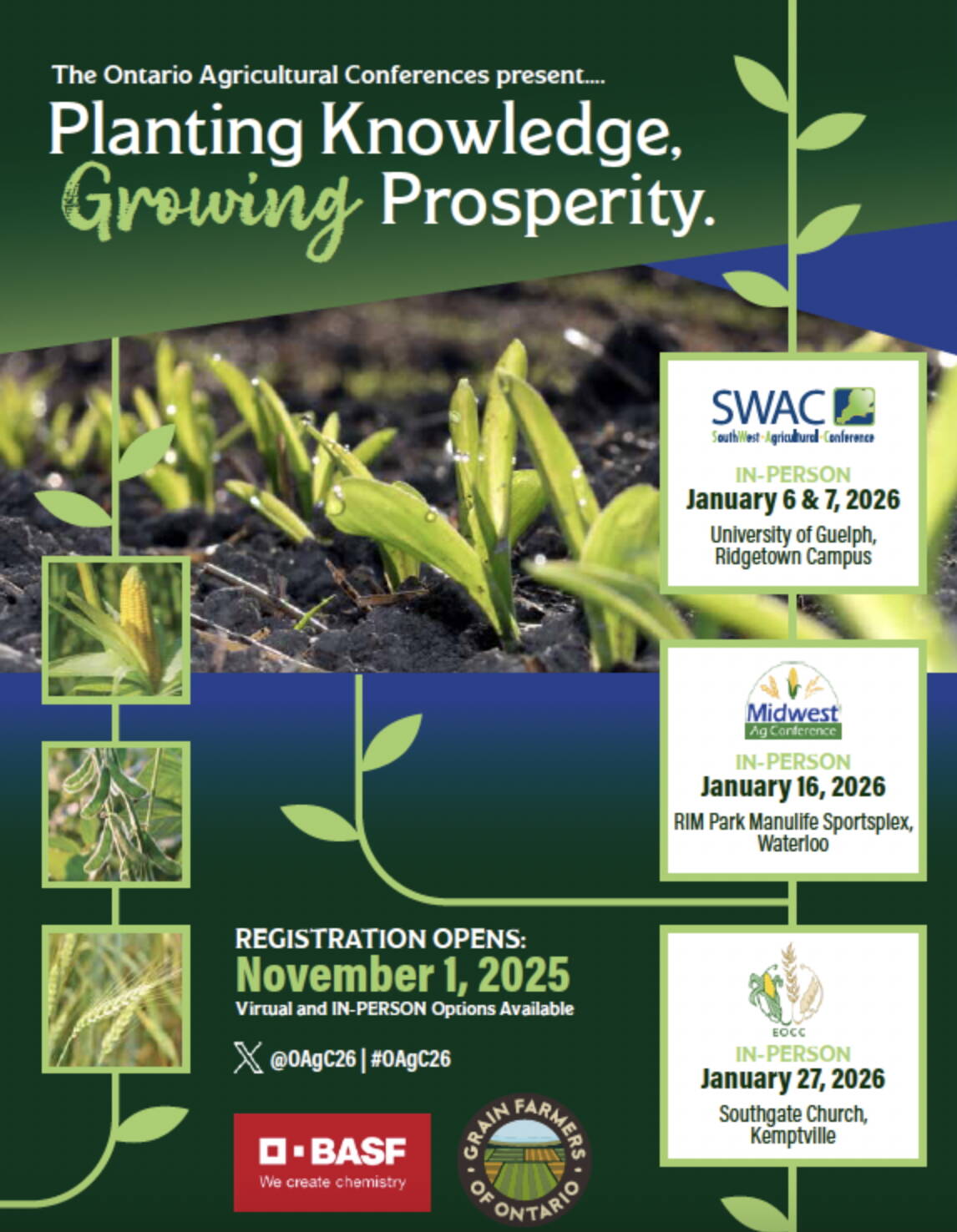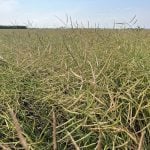As of July 8, the Ontario growing region has received average to above average precipitation while temperatures were one to three degrees below normal. Ontario corn, soybean and winter wheat crops have been developing under favourable conditions as the weather has been cooler and wetter than normal.
Quick look
Soybeans: Strong competition from Brazil has reduced Ontario export demand.
Corn: U.S. yield estimates are all over the map.
Wheat: Ontario’s winter wheat crop is forecasted to be over 2.5 million tonnes.
Statistics Canada’s June acreage survey confirmed its earlier survey conducted in late winter. Ontario farmers planted 2.913 million acres of soybeans, down 167,000 acres from last year. Ontario corn acres were estimated at 2.261 million, down only 15,000 acres from the 2022 area.
Read Also

Registration open for Ontario Agricultural Conference
The Ontario Agricultural Conference 2026 offers in-person and online access to expert insights, hands-on learning, and networking opportunities.
Grains Prices: Markets at a Glance
Above-average yields are expected for corn and soybeans, which will result in a year-over-year increase in production. Corn, soybean and wheat markets are moving through seasonal lows.
The USDA’s June acreage survey was a surprise to the trade. U.S soybean acres were down four million from the March 31 planting intentions report and down four million from the 2022 area.
U.S. corn acres were up two million acres from the March data and up 5.5 million acres from last year. The weather forecast for the U.S. Midwest calls for below normal precipitation from July 15 through July 31.
U.S. corn and soybean crops will likely experience yield drag due to adverse weather. This should result in higher prices later in fall. Brazil’s Safrinha harvest is occurring under favourable conditions and was approximately 20 per cent complete as of July 9. Export offers for Brazilian corn and soybean prices are discount to U.S. origin for nearby positions.
The U.S. winter wheat harvest was just over 50 per cent complete as of July 11. There have been delays due to intermittent rains. The European winter wheat harvest is occurring under favourable conditions.
Western Canadian and North Dakota spring wheat crops are experiencing yield drag due to limited rainfall. Russian origin wheat continues to dominate North African and Middle East wheat tenders.
The Canadian dollar has been trading near five-month highs. Canadian job growth during the first six months of 2023 totalled 289,800 positions. Canadian job vacancies at the end of April were 790,900. Canadian economic growth appears to be outpacing the U.S. The Canadian Consumer Price Index for May came in at 3.4 per cent.
We’re expecting additional interest rate hikes from the Bank of Canada until the index falls to the target of two per cent, which should cause additional Canadian dollar appreciation against the U.S. greenback.
Soybeans
Ontario farmers planted 2.913 million acres of soybeans this spring, according to Statistics Canada. This was down 2,000 acres from the earlier winter survey and down 167,000 acres from last year. Using a traditional abandonment rate and a five-year average yield of 49 bu./acre, production has potential to finish near 3.86 million tonnes, down 135,000 tonnes from last year.
The lower production estimate comes out of a historically tight carryout. The domestic crush pace has slowed during the summer, resulting in softer than expected domestic demand. Ontario exports have also tapered off due to strong competition from Brazil. Demand is lacking in the short-term, causing basis levels to deteriorate.
U.S. farmers planted 83.5 million acres of soybeans this spring, down four million acres from last year. Using a traditional abandonment rate and average yield of 49 bu./acre, production has potential to finish near 110.2 million tonnes, down from the 2022 output of 116.4 million tonnes and down from the five-year average of 113.8 million tonnes.
At the time of writing this article, Brazilian soybeans were offered at US$507/tonne f.o.b. Paranagua while U.S. soybeans were valued at $570/tonne f.o.b. the Gulf. Ontario soybeans were quoted at US$565/tonne f.o.b. St. Lawrence port.
The year-over-year decrease in U.S. soybean acres will make the market extremely sensitive to weather during the key pod-filling stage. The export window opportunity for U.S. soybeans will be shorter this fall due to the smaller exportable surplus.
The U.S. and Ontario markets will need to trade at a premium to South American origin from January forward. The market is now in a situation where it can’t afford a crop problem in Brazil or Argentina next winter.
What to do: We have advised producers to be 100 per cent sold on old-crop soybeans. Earlier in spring, we advised producers to sell 20 per cent of expected new crop. We will make our next recommendation once we have a better handle on South America for its 2023 crop. If adverse weather develops in South America, the soybean market would have potential to reach historical highs. The fundamentals have changed significantly over the past month.
Corn
Ontario farmers planted 2.2861 million acres of corn this spring. Using a traditional abandonment and an average yield of 166 bu./acre, production has potential to reach 9.4 million tonnes. This is unchanged from the 2022 output but up from the five-year average of nine million tonnes. Ontario domestic demand moves through a seasonal low during July and August.
Currently, Ontario corn is price competitive into Northern European destinations, which should limit the downside in the Ontario market.
U.S. farmers planted 94.1 million acres of corn this spring, up from the 2022 planted area of 88.6 million acres. Using a traditional abandonment rate and a five-year average yield of 168 bu./acre, production has potential to finish near 368 million tonnes, up from the 2022 output of 348 million tonnes and up from the five-year average crop size of 365 million tonnes. The 2022 yield was 173.3 bu./acre.
As of July 2, the U.S. corn crop was rated 51 per cent good to excellent, down from the rating of 64 per cent good to excellent last year. The lower ratings will likely result in a year-over-year decline in yields but this is still a large uncertainty. At this stage, yield estimates are all over the map.
The Brazilian harvest is occurring without any major weather issues. Total Brazilian output is still on track to reach 132 million tonnes, up 16 million tonnes from last year.
U.S. corn prices will function to encourage demand during the first half of the crop year. During the fall period, Brazilian farmers will be encouraged to plant soybeans instead of corn. Brazil’s first crop corn, which will be harvested during January 2024, has potential to be down sharply from January 2023. This will cause North American corn prices to make seasonal highs during the spring of 2024. This reinforces our sales strategy to sell regular increments over the winter and spring.
French output for 2023 was estimated at 11.7 million tonnes, up from the 2022 crop of 10.8 million tonnes.
At the time of writing this article, U.S. corn was offered at $240/tonne, down $30/tonne from 14 days earlier. Brazilian corn was offered at $215/tonne f.o.b. Paranagua. U.S. offers will be equal with Brazilian offers during the U.S. harvest period. French corn was quoted at $252/tonne f.o.b. La Pallice. Ontario corn was valued at US$230/tonne f.o.b. St. Lawrence port.
What to do: We’ve advised Ontario farmers to be 100 per cent sold on their 2022 production and 20 per cent sold on new crop. Be patient to make additional sales. We’re expecting stronger prices for Ontario corn during the winter and spring of 2024.
Wheat
Statistics Canada’s acreage survey was a non-event for the Ontario wheat market. Farmers planted 1.107 million acres last fall and there were 1.063 million acres remaining this spring. Harvested area will finish around 1.061 million acres. There was yield drag on the wheat crop earlier in spring but conditions over the past few weeks have reinforced our yield estimate of 88 bu./acre, down from last year’s yield of 96.5.
We continue to forecast an Ontario winter wheat crop of 2.541 million tonnes, up from last year’s output of 2.227 million tonnes. Ontario spring wheat production is estimated at 127,000 tonnes, down from 158,000 tonnes last year.
We expect one million tonnes will be used for domestic milling, approximately one million tonnes will be exported and 500,000 tonnes will be sold into domestic feed channels. If the wheat crop is mostly milling quality, we’ll see more volume pushed offshore rather than into the local feed market.
At the time of writing this article, French soft wheat was offered at $250/tonne f.o.b. Rouen; U.S. soft red winter was quoted at $255/tonne f.o.b. the Gulf and Ontario soft red winter was available at US$245/tonne f.o.b. St. Lawrence. Russian wheat was quoted at $240/tonne f.o.b. Black Sea port.
The Russian carryout from the 2022-23 crop year was estimated at 17 million tonnes, up from its regular ending stocks levels of six to eight million tonnes. Russia’s upcoming crop is estimated at 88 million tonnes, down from the 2023 output of 100 million tonnes.
Russia will dominate tenders in North Africa and the Middle East for 2023-24 crop year. During the fall period, we could see Russian wheat trade into Central and South America and into Southeast Asia.
German soft wheat output is estimated at 22.3 million tonnes, unchanged from last year; however, French soft wheat production is estimated at 33.6 million tonnes, up two million tonnes from last year. U.S. soft red winter estimates are hovering at 12.5 million tonnes, up 2.3 million tonnes from the 2022 crop.
The market has factored in the lower hard red winter supplies, which will basically cover U.S. domestic demand. There is no shortage of wheat in the world.
Canadian farmers planted 19.475 million acres of non-durum spring wheat, according to Statistics Canada. This was up from last year’s acreage of 18.036 million acres. Using a traditional abandonment rate and an average yield projection of 47.7 bu,/acre, non-durum spring wheat production has potential to come in at 25 million tonnes, down 650,000 from last year. (If we exclude 2021, the average yield for the six-year period from 2016 to 2022 was 52.5 bu./acre).
What to do: We’ve advised producers to be 100 per cent sold on old crop. Be patient to sell new crop. We’ll be aggressive on 2023 production during October and November, once the Northern Hemisphere harvest pressure has wrapped up.















